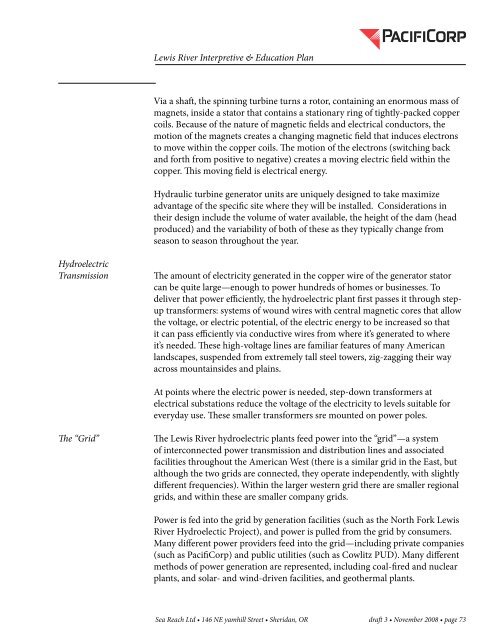The Lewis River Hydroelectric Projects - PacifiCorp
The Lewis River Hydroelectric Projects - PacifiCorp
The Lewis River Hydroelectric Projects - PacifiCorp
Create successful ePaper yourself
Turn your PDF publications into a flip-book with our unique Google optimized e-Paper software.
<strong>Lewis</strong> <strong>River</strong> Interpretive & Education Plan<br />
Via a shaft, the spinning turbine turns a rotor, containing an enormous mass of<br />
magnets, inside a stator that contains a stationary ring of tightly-packed copper<br />
coils. Because of the nature of magnetic fields and electrical conductors, the<br />
motion of the magnets creates a changing magnetic field that induces electrons<br />
to move within the copper coils. <strong>The</strong> motion of the electrons (switching back<br />
and forth from positive to negative) creates a moving electric field within the<br />
copper. This moving field is electrical energy.<br />
Hydraulic turbine generator units are uniquely designed to take maximize<br />
advantage of the specific site where they will be installed. Considerations in<br />
their design include the volume of water available, the height of the dam (head<br />
produced) and the variability of both of these as they typically change from<br />
season to season throughout the year.<br />
<strong>Hydroelectric</strong><br />
Transmission<br />
<strong>The</strong> amount of electricity generated in the copper wire of the generator stator<br />
can be quite large—enough to power hundreds of homes or businesses. To<br />
deliver that power efficiently, the hydroelectric plant first passes it through stepup<br />
transformers: systems of wound wires with central magnetic cores that allow<br />
the voltage, or electric potential, of the electric energy to be increased so that<br />
it can pass efficiently via conductive wires from where it’s generated to where<br />
it’s needed. <strong>The</strong>se high-voltage lines are familiar features of many American<br />
landscapes, suspended from extremely tall steel towers, zig-zagging their way<br />
across mountainsides and plains.<br />
At points where the electric power is needed, step-down transformers at<br />
electrical substations reduce the voltage of the electricity to levels suitable for<br />
everyday use. <strong>The</strong>se smaller transformers sre mounted on power poles.<br />
<strong>The</strong> “Grid”<br />
<strong>The</strong> <strong>Lewis</strong> <strong>River</strong> hydroelectric plants feed power into the “grid”—a system<br />
of interconnected power transmission and distribution lines and associated<br />
facilities throughout the American West (there is a similar grid in the East, but<br />
although the two grids are connected, they operate independently, with slightly<br />
different frequencies). Within the larger western grid there are smaller regional<br />
grids, and within these are smaller company grids.<br />
Power is fed into the grid by generation facilities (such as the North Fork <strong>Lewis</strong><br />
<strong>River</strong> Hydroelectic Project), and power is pulled from the grid by consumers.<br />
Many different power providers feed into the grid—including private companies<br />
(such as <strong>PacifiCorp</strong>) and public utilities (such as Cowlitz PUD). Many different<br />
methods of power generation are represented, including coal-fired and nuclear<br />
plants, and solar- and wind-driven facilities, and geothermal plants.<br />
Sea Reach Ltd • 146 NE yamhill Street • Sheridan, OR draft 3 • November 2008 • page 73
















